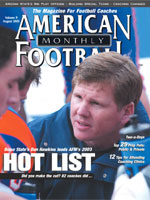AMERICAN FOOTBALL MONTHLY THE #1 RESOURCE FOR FOOTBALL COACHES
Article CategoriesAFM Magazine
|
Marching to the Beat of a Different DrumResistance \'speed\' training, an underutilized toolby: Danny Arnold PLEX Sports & Rehab © More from this issue With such noticeable improvements in training regimens throughout the years, there is one method that is still underutilized – resistance “speed” training (RST). RST is a method that will add explosive power and speed to any athlete, if done correctly. The reason for this is because muscle contraction force is generated by the recruitment of the necessary number of muscle fibers to meat the load demand placed on them. Thus an increase in intensity of contractions leads to an increase recruitment of fast twitch muscle fibers as the stimulus potential generated by the central nervous system rises. In other words, the body is forced to recruit more fast twitch muscle fibers. In additi....The full article can only be seen by subscribers. Subscribe today!
|
|
|||||||
| HOME |
MAGAZINE |
SUBSCRIBE | ONLINE COLUMNISTS | COACHING VIDEOS |
Copyright 2025, AmericanFootballMonthly.com
All Rights Reserved





